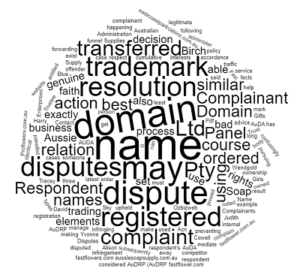Table of Contents
Toggle Domain name disputes exist in civil litigation if you have a genuine dispute over the use of a domain name – for example, a competitor is using a domain name which is exactly the same, or very similar, to your business name or domain name to funnel traffic away from your business.
Domain name disputes exist in civil litigation if you have a genuine dispute over the use of a domain name – for example, a competitor is using a domain name which is exactly the same, or very similar, to your business name or domain name to funnel traffic away from your business.
If this is happening to you then you may have a genuine domain name dispute, and we may be able to help you through the domain name disputes and resolution process.
The first thing to do if you realise that a competitor or cyber-squatter is using a competing domain name in bad faith is make a complaint pursuant to the domain name dispute resolution process under of the AuDRP.
The AUDA is the body set up to manage asn.au, com.au, id.au, net.au and org.au domain names.
The auDRP was set up to mediate and decide all types of Australian domain name disputes.
If your dispute relates to a asn.au, com.au, id.au, net.au and org.au domain names, then you will be able to use the auDRP process to resolve these domain name disputes without having to go through the expensive Courts process.
DEDICATED TEAM – COMMERCIALLY MINDED – PROVEN RESULTS
REQUEST A FREE CASE EVALUATION
OR CALL: 1300 545 133 FOR A FREE PHONE CONSULTATION
Domain Name Disputes
The auDA are the .au Domain Administration, the body set up to administer and manage .au domain names and .au domain name disputes.
The auDA has an internal dispute resolution policy in relation to .au domain names.
The auDA dispute resolution policy is known as the auDRP.
Domain Name Disputes – the auDRP Procedure
The auDRP contains the following information:
- Background to the auDRP;
- Application of the auDRP;
- auDA approved providers;
- How to file a complaint under the auDRP;
- How to file a response under the auDRP;
- Remedies available to complainant;
- Enforcement of auDRP decisions;
- Publication of auDRP proceedings and decisions;
- Review of policy;
- Schedule A – .au dispute resolution policy; and
- Schedule B – rules for .au dispute resolution policy.
We will explain all of the relevant issues below in relation to domain name disputes.
How to File a Complaint under the auDRP
To commence the domain name disputes procedure, the auDRP suggests that you do the following:
- Read Schedule A and Schedule B (the auDRP) thoroughly beforehand;
- Make the application in the approved form to one of the approved auDRP providers (Resolution Institute (formerly LEADR & IAMA) or the World Intellectual Property Organisation (WIPO)).
- Meet the requirements of Paragraph 3 of the auDRP Rules in Schedule B of the auDRP;
- Meet the requirements contained in the approved provider’s rules; and
- Pay the required fee.
How to File a Response under the auDRP
Once served with a notice of complaint form, the respondent must file a response within twenty (20) days.
The response to the auDRP complaint must be in accordance with paragraph 5 of the auDRP set out in Schedule B.
If no response is filed within the allocated timeframe, then the panellist (or panellists) will decide the application based upon the complainant’s material.
Remedies Available to Complainant
The complainant may ask for the domain name to be either cancelled or transferred to them.
Paragraph 6 of the auDRP says:
A Complainant may seek to have the domain name licence:
a) cancelled, in which case the domain name will become available for registration in the normal way; or
b) transferred to themselves, but only if the registrar determines that they are eligible to hold the domain name under the relevant policy rules.
Enforcement of auDRP Decisions
There is no appeals process under the auDRP.
If the losing party is not happy with the result, then they must commence legal action within ten (10) business days from the date the decision is handed down.
If the losing party is not happy with any of the procedural matters, then these matters should be raised directly with the approved panellist.
Essential Elements of Domain Name Disputes
A person is entitled to complain about the registration or use of a domain name where:
- The domain name is identical or confusingly similar to a name, trademark or service mark in which the complainant has rights; and
- The respondent to the complaint has no rights or legitimate interests in respect of the domain name; and
- The respondent’s domain name has been registered or subsequently used in bad faith.
It is to be noted that the three elements of a complaint are cumulative; they must all be proved if the complaint is to be upheld. It follows that if any of the limbs of the auDRP are unable to be established, the Complaint cannot succeed.
We will address the individual elements in further detail below.
The Domain Name is Identical or Confusingly Similar to a Name, Trademark or Service Mark in which the Complainant has Rights
The issues in relation to this essential element include:
- What is a name in relation to auDRP domain name disputes?
- What is a trademark in relation to auDRP domain name disputes?
- What is a service mark in relation to auDRP domain name disputes?
- What does identical mean?
- What does confusingly similar mean?
- What does “having rights” in a name, trademark or service mark mean?
I will discuss these in further detail below.
What is a Name in Relation to auDRP Domain Name Disputes?
A footnote in the auDRP states that:
For the purposes of this policy, auDA has determined that a “name … in which the complainant has rights” refers to:
a) the complainant’s company, business or other legal or trading name, as registered with the relevant Australian government authority; or
b) the complainant’s personal name.
This means that a name must be a registered company, business, or legal name; or a person’s personal name.
This would include a company, business name, or trademark registered with ASIC or IP Australia for example.
What is a Trademark or Service Mark in Relation to auDRP Domain Name Disputes?
A trademark is defined at section 17 of the Trade Marks Act 1995 (Cth) to be:
A trade mark is a sign used, or intended to be used, to distinguish goods or services dealt with or provided in the course of trade by a person from goods or services so dealt with or provided by any other person.
For the purposes of the auDRP a trademark can be a registered trademark, but also an unregistered trademark.
In Hertz Systems Inc. v. Throne Ventures Pty. Ltd. [2010] AUDND 4 Debrett G. Lyons, Sole Panelist said:
The Policy (adDRP) does not distinguish between registered and unregistered trademark rights … however a trademark registered with a national authority is prima facie evidence of trademark rights for the purposes of the Policy … A complainant need not have a registered trade mark if it can show unregistered trade mark rights garnered through use and reputation.
It was also held in Crosby Furnishings Pty Ltd v. Diablo-Group Pty Ltd. [2011] AUDND 22 when Debrett G. Lyons, Sole Panelist again said:
Paragraph 4(a)(i) of the Policy [auDRP] does not distinguish between registered and unregistered trademark rights. It is accepted that a trade mark registered with a national authority is prima facie evidence of trademark rights for the purposes of the Policy.
It is important that you satisfy the requirements of an unregistered trademark if this is your only way of satisfying this section of the auDRP.
A registered trademark being evidence of a trademark is to be distinguished from a registered trademark being evidence of having rights in that trademark. It only satisfies the first and not the latter.
In Michael Arnold, Lorimax Pty Ltd v. Tolling Customer Ombudsman Pty Ltd [2016] AUDND 26 Nicholas Smith Sole Panelist said quoting the Uniform Domain Name Dispute Resolution Policy (“UDRP”):
For the complainant to satisfy that requirement, the trademark that is the subject of the application must either: (i) satisfy the test for being a common law or unregistered trademark; or (ii) constitute a ‘name’ within Note 1 of the Policy – i.e., be the complainant’s company, business or other legal or trading name, as registered with the relevant Australian government authority, or be the complainant’s personal name.
So, those are the requirements for names, but what does “identical” or “confusingly similar” mean?
What does Identical or Confusingly Similar Mean?
The auDRP Policy does not provide guidance as to the intended meaning of “identical” or “confusingly similar”. However, there has been a number of cases which have discussed this issue.
In GlobalCenter Pty Ltd v. Global Domain Hosting Pty Ltd, WIPO Case No. DAU2002-0001 a three (3) member panel considered “identical” or “confusingly similar” and said:
As is the case under the UDRP, essential or virtual identity is sufficient for the purposes of the Policy … Likewise, the test of confusing similarity under the Policy is confined to a comparison of the disputed domain name and the name or trademark alone, independent of the other marketing and use factors usually considered in trademark infringement or unfair competition cases.
In The Crown Right on the State of Tasmania T/A Tourism Tasmania v Gordon James Craven WIPO Case No. DAU2003-0001, a three (3) member panel said:
In GlobalCenter … a three-member Panel decided that, as is the case under the UDRP, essential or virtual identity is sufficient for the purposes of the Policy … Likewise, the Panel in the GlobalCenter case held that the test of confusing similarity under the Policy is confined to a comparison of the disputed domain name and the name or trademark alone, independent of the other marketing and use factors usually considered in trademark infringement or unfair competition cases.
In BlueChip InfoTech Pty Limited v Roslyn Jan and Blue Chip Software Development Pty Limited LEADR – Case No. 06/03 Michael Daniel, Panellist discussed these issues, citing The Crown Right on the State of Tasmania T/A Tourism Tasmania v Gordon James Craven (“Tourism Tasmania Case”) said:
Essential or virtual identity is sufficient
This Blue Chip case has been cited in hundreds of further auDRP cases as the correct authority.
Further, in the matter of Seatgeek, Inc. v. Lokesh Kumar WIPO Case No. DAU2018-0019 discussed this matter further John Swinson Sole WIPO Panelist said:
By applying the test for identity or confusing similarity, which requires a visual, phonetic and conceptual comparison of both the Trade Mark and the Disputed Domain Name, the Trade Mark and the Disputed Domain Name are undoubtedly identical or confusingly similar.
So, if you can prove a trademark, service mark or a name – and also that the infringing domain name is identical or confusingly similar to that trademark, service mark or a name – then the complainant will also need to prove that they have rights in that trademark, service mark or a name.
What does “Having Rights” in a Name, Trademark or Service Mark Mean?
Simply put, if the complainant can show it has a name, company, business or other legal or trading name, as registered with the relevant Australian government authority; or the complainant’s personal name, or a registered or unregistered trademark – then for the purpose of a dispute under the auDRP, the claimant has rights in the name, trademark, or service mark.
The auDRP says:
For the purposes of this policy, auDA has determined that a “name … in which the complainant has rights” refers to:
a) the complainant’s company, business or other legal or trading name, as registered with the relevant Australian government authority; or
b) the complainant’s personal name.
This would include a company, business name, or trademark registered with ASIC or IP Australia for example.
What are not “Rights or Legitimate Interests in Respect of the Domain Name”?
Rights or legitimate interests in respect of the domain name cannot be inferred by virtue of the registration of the domain name and/or allegedly satisfying the requirements of the registrar.
A footnote in the auDRP says:
For the purposes of this policy, auDA has determined that “rights or legitimate interests in respect of the domain name” are not established merely by a registrar’s determination that the respondent satisfied the relevant eligibility criteria for the domain name at the time of registration.
If the complainant satisfied the first limb of the auDRP, then they must also satisfy the next limb and show that the respondent has no rights or interest in the disputed domain name.
The Respondent has no Rights or Legitimate Interests in Respect of the Domain Name
Paragraph 4(c) of auDRP lists three (3) examples of what may not be a right or legitimate interest in relation to the domain name, namely:
- Use, or demonstrable preparations to use, the domain name in connection with a bona fide offering of goods or services; or
- The respondent being commonly known by that domain name; or
- Making a legitimate non-commercial or fair use of the domain name, without intent for commercial gain to misleadingly divert consumers.
Note – the wording of 4(c) of the auDRP says “or” which means that any of the examples may be used, and they do not need to be cumulative.
Further, in Macquarie Group Limited v. McQuarie Group Pty Ltd / Roland Storti [2013] AUDND 11, Andrew F. Christie, Sole Panelist said:
The fact that a domain name consists of part of a respondent’s personal or business name does not, of itself, establish that the respondent has a right or legitimate interest in the domain name. More is required. In this Panel’s opinion, where a respondent’s claim to a right or legitimate interest in a domain name is based on a commonality between the domain name and the respondent’s personal or business name, it is necessary to show that there is some meaningful practical connection between the domain name and the activities (whether personal or commercial) carried out under the respondent’s personal or business name.
I will explain these in more detail below.
Use, or Demonstrable Preparations to Use, the Domain Name
The use of the domain name must be in connection with a bona fide offering of goods or services.
made, done, presented, etc., in good faith; without deception or fraud; authentic; true:
So, the offering of goods and services must be authentic and/or true in good faith; and done without deception or fraud.
The words in the domain name must be descriptive of the Respondent’s goods and/or services and/or business name.
In Oki Data Americas, Inc. v. ASD, Inc., WIPO Case No. D2001-0903, WIPO gave four (4) requirements which would help to decide if a respondent had a bona fide use of the disputed domain name, the panel said:
To be “bona fide,” the offering must meet several requirements. Those include, at the minimum, the following:
1. Respondent must actually be offering the goods or services at issue.
2. Respondent must use the site to sell only the trademarked goods; otherwise, it could be using the trademark to bait Internet users and then switch them to other goods.
3. The site must accurately disclose the registrant’s relationship with the trademark owner; it may not, for example, falsely suggest that it is the trademark owner, or that the website is the official site, if, in fact, it is only one of many sales agents.
4. The Respondent must not try to corner the market in all domain names, thus depriving the trademark owner of reflecting its own mark in a domain name.
To assess if the respondent has been using the domain name in good faith requires an evaluation of the facts of each case, and the motivation behind it.
In Confo Pty Ltd v. Meridian Project Consulting Pty Ltd Case No. LEADR-auDRP1020 Andrew F. Christie, a Sole Panellist said:
To determine whether a use of a domain name is in good faith requires a consideration of the motivation of the entity undertaking it. That, in turn, requires an evaluation of the facts and evidence contained in the case record.
The Respondent being Commonly Known by that Domain Name
Again, there is no real guidance in relation to this in the auDRP. Instead, the words are to be given their common usual meaning.
often; frequently; usually; generally; ordinarily.
So, the claimant must attempt to prove that the respondent is not often, frequently, usually, generally, or ordinarily known by that domain name.
It is more difficult for a complainant to prove a negative, but the onus is on the complainant to show a prima facie case.
In Zynga Inc. v. Graytech Hosting Pty Ltd, Annette Nazarova [2016] AUDND 32 Warwick A. Rothnie, Sole Panellist said, citing GlobalCenter Pty Ltd v. Global Domain Hosting Pty Ltd:
The onus of proving this requirement, like each element, falls on the Complainant. Previous panels have recognized the difficulties inherent in proving a negative, however, especially in circumstances where much of the relevant information is in, or likely to be in, the possession of the respondent. Accordingly, it is usually sufficient for a complainant to raise a prima facie case against the respondent under this head and an evidential burden will shift to the respondent to rebut that prima facie case.
The claimant can also attempt to show that the domain name was not being used for a legitimate non-commercial or fair use reason.
Legitimate Non-Commercial or Fair Use of the Domain Name
Non-commercial is self-explanatory. If you are making money from the domain name, then it is a commercial enterprise.
A blog without advertising may be considered legitimate non-commercial use.
Fair use is the doctrine relating to whether a person has a genuine right to use another person’s intellectual property.
In the USA (with UDRP and WIPO), because of constitutionally protected free speech, the panellists have found that criticism and parody can be a fair use. This is of course subject to a number of caveats.
However, in Australia (with the auDRP) it has not been fully explored. In Miltenyi Biotec GmbH v. Rachel A. Liu-Williams [2015] AUDND 29 Andrew F. Christie, Sole Panelist said:
At the date of this decision, it appears that there is no consensus view (indeed, no view) of auDRP panels on the issue of whether use of a domain name to resolve to a genuine criticism site gives rise to rights or legitimate interests in the domain name. In a situation where there is no consensus view of panels under the auDRP, it makes great sense to consider the consensus views of panels under the domain name dispute resolution policy on which the auDRP is based – namely, the Uniform Domain Name Dispute Resolution Policy (“UDRP”).
It is in the writer’s opinion that this issue is still the subject of diverging opinion in Australia.
The most common fair use argument is the right of a legitimate reseller or distributor of goods and/or services to use the name.
In Oki Data Americas, Inc. v. ASD, Inc., WIPO Case No. D2001-0903 sets out the principals which need to be established.
In Oki Data, David H. Bernstein, Sole Panellist said:
In this case, Respondent’s conduct meets all these factors. Respondent is an authorized seller and repair center, is using the okidataparts.com site to promote only OKIDATA goods and services, and prominently discloses that it is merely a repair center, not Oki Data itself. It has not registered numerous okidata-related domain names, and has not improperly communicated with Oki Data customers … Complainant has not presented any other evidence that undermines the bona fides of Respondent’s use. Accordingly, the Panel finds that the Respondent, as an authorized sales and repair dealer for Complainant’s goods, has a legitimate interest in using the Domain Name to reflect and promote that fact.
The Respondent’s Domain Name has been Registered or Subsequently Used in Bad Faith
Section 4(b) of the auDRP outlines circumstances where the auDA has decided is bad faith.
Section 4(b) says:
[t]he following circumstances, in particular but without limitation, if found by the Panel to be present, shall be evidence of the registration and use of a domain name in bad faith:
(i) circumstances indicating that you have registered, or you have acquired the domain name primarily for the purpose of selling, renting, or otherwise transferring the domain name registration to another person for valuable consideration in excess of your documented out-of-pocket costs directly related to the domain name; or
(ii) you have registered the domain name in order to prevent the owner of a name, trademark or service mark from reflecting that name or mark in a corresponding domain name; or
(iii) you have registered the domain name primarily for the purpose of disrupting the business or activities of another person; or
(iv) by using the domain name, you have intentionally attempted to attract, for commercial gain, Internet users to a website or other online location, by creating a likelihood of confusion with the complainant’s name or mark as to the source, sponsorship, affiliation, or endorsement of that website or location or of a product or service on that website or location; or
(v) if any of your representations or warranties as to eligibility or third-party rights given on application or renewal are, or subsequently become, false or misleading in any manner.
So, as you can see, these cover most of the reasons that a dispute may arise.
Cyber-squatting – the registration of a domain name for the purpose of selling, renting, or otherwise transferring the domain name registration to another person for valuable consideration.
Domain parking – buying the domain name and parking it to prevent a legitimate owner of a name, trademark or service mark from using it.
Domain forwarding – buying a competitor’s domain name, be it identical or confusingly similar, in order to .301 redirect to a competitor’s site.
False information – the giving of false or misleading representations or warranties at the time of registration of the domain name.
Conclusion for Domain Name Disputes
As long as a complainant can make out the elements of the complaint in accordance with what the cases have said about (1) (2) & (3) above, then the complainant may be able to get ownership of the infringing domain name transferred to them, or at the very least, an order preventing the offender from using it.
If someone has registered a domain name (exactly the same, or very similar to your domain name) and is using it ‘in bad faith’ then the auDA and their domain name dispute resolution process may be the best course of action for you.
Cases Found for the Complainant
In Fast Enterprises Pty Ltd V Gifts For Girls Pty Ltd (Acn 098 896 372) the facts were:
The Complainant owned the domain name “fastflowers.com.
The Respondent registered the domain name “fastflower.com.
The Respondent was forwarding the “fastflower.com.au” domain name to their website “Proflowers.com.au”.
The result of the AuDRP was that the Panel ordered that the disputed domain names be transferred to the Complainant.
In Wendgold Pty Ltd V. Ozbizweb Pty Ltd As Trustee Of The Blue Sky Trust the facts were:
After a disagreement, the business relationship between a business owner and a domain name reseller was terminated.
After termination, Ozbizweb tried to retain the domain name.
The Panel ordered that the domain name “eastcoastparkcabins.com.au” be transferred from the Respondent to the Complainant.
In David Harry Birch and Judith Alison Birch trading as Aussie Soap Supplies v Yvonne Tracey Cowell trading as Aussie Soap Supply the Panel ordered that “aussiesoapsupply.com.au” be transferred to the Complainants.
In Veneziano Coffee Pty Ltd. v. Rick Caspersen [2012] AUDND 15 the respondent previously contracted as a distributor for the claimant. The respondent traded under the name “Veneziano Coffee Sunshine Coast”.
The distribution agreement was terminated, but the respondent continued to use the name.
Therefore, the panel found that the Respondent has no rights or legitimate interests in the disputed domain name and the panel ordered that the disputed domain name be transferred to the Complainant.
Local Cases Found for the Respondent
In IVF Sunshine Coast Pty Ltd v. Fertility Solutions Sunshine Coast Pty Ltd [2008] AUDND 26 The Hon Neil Anthony Brown QC, Sole Panellist, correctly found against the complainant because the complainants solicitors failed to correctly submit sufficient detail. In his decision, The Hon Neil Anthony Brown QC said:
As has already been seen, the parts of the Complaint relating to this element are exceedingly brief. The entire submission of the Complainant is that:
“ii) FSSC has “no rights or legitimate interests in respect of the domain name” (see 4 A a ii below).”
That submission is an assertion which contains no facts to support it and there is therefore no factual basis on which the Panel can conclude that the Complainant has made out a prima facie case. Accordingly, the Panel is unable to conclude that the Complainant has made out this element, which is an essential element that it must prove.
This is why it is very important to engage suitably qualified solicitors.
Explaining the Jargon
You will need to know who and what everything and everyone is.
You will also need to know the legal jargon and terminology.
What is ICANN?
ICANN is the abbreviation used for the Internet Corporation for Assigned Names and Numbers.
As you have probably guessed, ICANN is the international, not-for-profit organisation which operates and helps to regulate the Internet’s domain name system, and accredits generic top-level domain (gTLD) registrars.
It does a lot more. Check out their website for more information – https://www.icann.org/
What is the auDA?
The auDA is the abbreviation used for the .au Domain Administration Ltd.
The auDA is the is the administrator and self-regulatory policy body for the .au ccTLD.
The auDA is the organisation responsible for facilitating the .au Dispute Resolution Policy.
It does a lot more. Check out their website for more information – https://www.auda.org.au/
What is WIPO?
WIPO is the abbreviation used for the World Intellectual Property Organisation.
WIPO is the global forum for intellectual property (IP) services, policy, information and cooperation.
WIPO does a lot more. Check out their website for more – https://www.wipo.int/portal/en/index.html
What is the UDRP?
The UDRP is the abbreviation used for the Uniform Domain-Name Dispute-Resolution Policy.
The UDRP is the policy issued by ICANN which all domain name registrars must follow.
A copy of the UDRP is here – https://www.icann.org/resources/pages/policy-2012-02-25-en
What is the auDRP?
auDRP is the abbreviation used for the .au Dispute Resolution Policy.
The auDRP is the Australian equivalent of the UDRP which was set up, and administered by, the auDA to manage and resolve domain name disputes involving .au domain names.
The auDRP can be found here – https://www.auda.org.au/policies/index-of-published-policies/2016/2016-01/
A pdf version of the auDRP can be found here – https://www.auda.org.au/assets/pdf/auda-2016-01.pdf
What is a TLD?
TLD is the abbreviation used for the phrase “top-level domain”.
A TLD is a domain name which is at the highest level in the hierarchy of domain names in the Internet.
Examples of original TLD’s include .com .org .net etc.
What is a gTLD?
gTLD is the abbreviation used for the phrase “generic top-level domains”.
A gTLD can include .com .org and .net but also include most other TLD’s including .lawyer for example.
gTLD’s also include ccTLD’s.
What is a ccTLD?
ccTLD is the abbreviation used for the phrase “country code top-level domains”.
A ccTLD is a TLD used by, or reserved for, a country, territory, or a sovereign state, or is particularly identified with a country code. Obvious examples include .au .nz and .uk.
DEDICATED TEAM – COMMERCIALLY MINDED – PROVEN RESULTS
REQUEST A FREE CASE EVALUATION
OR CALL: 1300 545 133 FOR A FREE PHONE CONSULTATION








